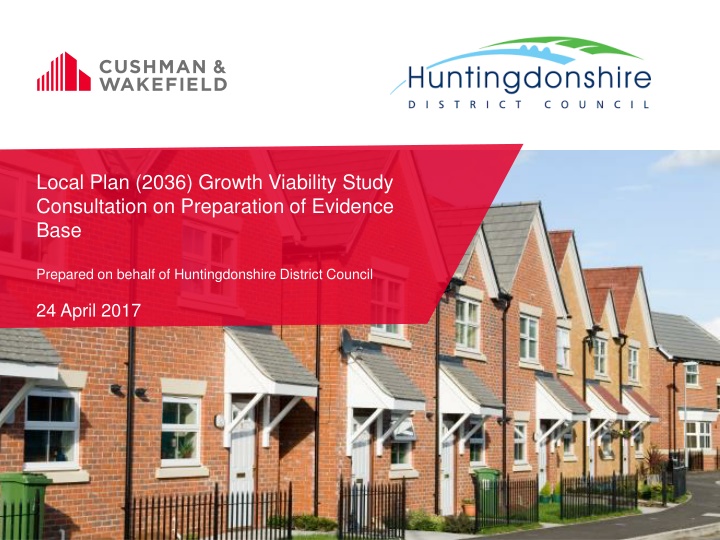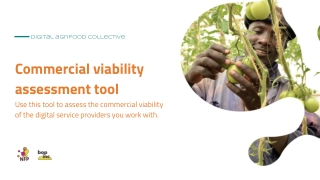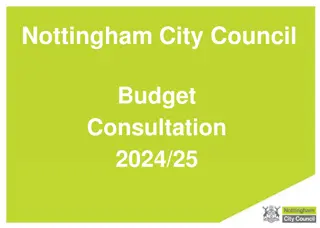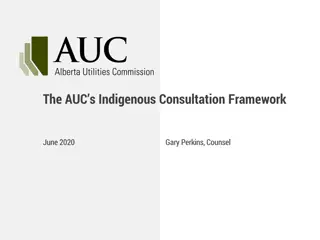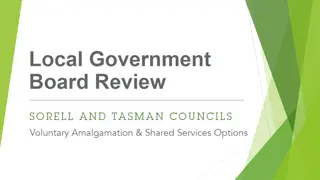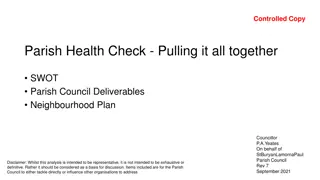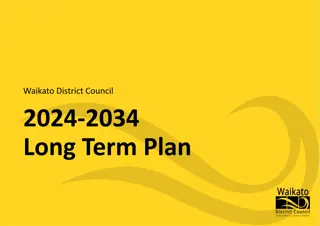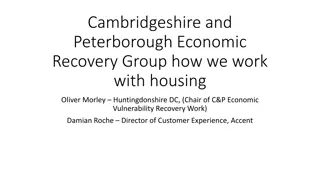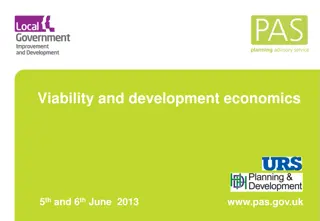Viability Study Consultation for Huntingdonshire District Council 2036 Growth Plan
Providing viability evidence to support the emerging Local Plan, the Huntingdonshire District Council 2036 Growth Viability Study focuses on policy development, affordable housing testing, and viability testing for various site types. The study aims to ensure viability, deliverability, and maximize gains through planning obligations to improve infrastructure and affordable housing delivery. It also supports the deliverability of the HLP2036 by balancing growth encouragement with district-wide development. The assessment follows NPPG guidelines and aims to achieve competitive returns for landowners and developers.
Download Presentation

Please find below an Image/Link to download the presentation.
The content on the website is provided AS IS for your information and personal use only. It may not be sold, licensed, or shared on other websites without obtaining consent from the author.If you encounter any issues during the download, it is possible that the publisher has removed the file from their server.
You are allowed to download the files provided on this website for personal or commercial use, subject to the condition that they are used lawfully. All files are the property of their respective owners.
The content on the website is provided AS IS for your information and personal use only. It may not be sold, licensed, or shared on other websites without obtaining consent from the author.
E N D
Presentation Transcript
Local Plan (2036) Growth Viability Study Consultation on Preparation of Evidence Base Prepared on behalf of Huntingdonshire District Council 24 April 2017
Agenda Welcome and Introduction 10.00 10.10 Approach to Viability Testing 10.10 10.30 Viability Assumptions 10.30 11.00 Discussion 11.00 11.50 Summary and Close 11.50 2
Purpose and scope of instructions To provide viability evidence to support the emerging Local Plan, Huntingdonshire Local Plan 2036, including: a. Policy development viability testing b. Affordable housing requirement viability testing c. Viability testing for a range of site types The primary objectives of the Growth Viability Assessment are to: a. and policies are viable and deliverable; and b. enable the Council to maximise gain through planning obligations in order to improve delivery of infrastructure and affordable housing, whilst balanced against the desire to encourage growth and delivery across the district. support the deliverability of the HLP2036, by ensuring that the Local Plan vision, allocations Huntingdonshire District Council | Cushman & Wakefield 4
Viability context NPPG: Need to show an appropriate balance Area-based approach No particular valuation method advised appropriate available evidence Sample an appropriate range of sites across its area Viability buffer All development costs including abnormals Huntingdonshire District Council | Cushman & Wakefield 5
What is a viability test? Paragraph 2.1: An objective financial viability test of the ability of a development project to meet its costs including the costs of planning obligations, while ensuring an appropriate site value for the land owner and market risk adjusted return to the developer in delivering the project. Paragraph 173 of the NPPF states Provide competitive returns to a willing land owner and willing developer to enable the development to be deliverable A requirement of paragraph 015 of the NPPG for: A competitive return for the land owner is the price at which a reasonable land owner would be willing to sell their land for the development Huntingdonshire District Council | Cushman & Wakefield 6
Principles of economic viability testing Huntingdonshire District Council | Cushman & Wakefield 7
C&W Approach for Typology Viability Testing Research Inputs & Factors Calculate Residual Land Value (RLV) Compare RLV with the return for a willing landowner (Benchmark Site Value (BLV)) Value areas The Gross Development Value Input to Calculate RLV Is the RLV sufficient? Residual Land Value less Benchmark Land Value Scheme Typologies Less all development costs including profit and planning requirements (including CIL) Draft Local Plan Policy If + /ve - - Viable If - / ve - Not Viable (Sense Test e.g. lower affordable housing) Equals the residual land value (RLV) Appraisal assumptions / sensitivities Huntingdonshire District Council | Cushman & Wakefield 8
Approach to Residential Typologies Drawing on individual site assessments undertaken through an Environmental Capacity and Land Availability Assessment, HLP 2036 includes a package of sites proposed as capable of delivering the development strategy for the district up to 2036. For each site, HLP 2036 has assumed certain development densities, and the proposed modelling has sought to reflect this by way of the typologies tested On this basis, a number of different typologies will be tested to reflect the different circumstances of sites across Huntingdonshire District, as proposed in the Local Plan, including Huntingdonshire District Council | Cushman & Wakefield
Viability Testing Assumptions Huntingdonshire District Council | Cushman & Wakefield 10
Approach to Residential Typologies Market Area (expressed through different assumptions regarding sales values and benchmark land values) Development Size A range from 11 dwellings, through to 1,500 dwellings Development Context Greenfield Previously Developed Land Development Density: 60 dwellings per hectare (dph) - (Tested at 50 dwellings, Previously Developed Land only) 50 dwellings per hectare (dph) - (Tested at 25 dwellings (Ramsey); 50 dwellings (Ramsey, Huntingdon, and St Ives); and 100 dwellings (Huntingdon) all assuming Previously Developed Land only) 40 dwellings per hectare (dph) - (Tested at 1,500 dwellings, Greenfield and 240/sqft value band only) 35 dwellings per hectare (dph) (Tested at 11 1,500 dwellings, Greenfield and Previously Developed Land) Huntingdonshire District Council | Cushman & Wakefield
Approach to Residential Typologies Value Points Broadly reflecting the location of the allocations that the typologies tested seek to reflect, the following value points are proposed to be tested, by density typology. Huntingdonshire District Council | Cushman & Wakefield
Approach to Residential Typologies Dwelling Sizes These are sensitive to the development density tested, as follows: Density Tested Average Dwelling Size 1,050 (market) sqft For market dwellings, an average size of 1,050 sqft was assumed, and which is within the average range suggested by analysis of the SHMA recommendations (Relates to Policy LP20 regarding housing mix) regarding houses (1,041sqft to 1,111sqft). 35dph For the affordable dwellings, an average size of 750sqft was agreed with the HDC Policy and Enabling Officer. 950 sqft (market) Assumes a smaller average size of dwelling than 35dph on account of the higher density (Presuming all houses). 40dph For the affordable dwellings, an average size of 750sqft was agreed with the HDC Policy and Enabling Officer. 885 sqft Assumes a blend of apartments (25%) and townhouses (75%). 50dph Assumes all apartments average 600sqft net. This assumes a net to gross ratio of 85%, for the purposes of calculating Gross Internal Area. Assumes the town houses average 975sqft. The blended (Net Internal Area) average of the apartments and townhouses is 885sqft 600 sqft Assumes all apartments (600sqft net, assuming a net to gross ratio of 85%, for the purposes of calculating Gross Internal Area) 60dph Huntingdonshire District Council | Cushman & Wakefield
Build Costs (Houses) Build costs for houses are based on BCIS (November 2016) rebased for Cambridgeshire) - - - - Garages included in base construction Focus on All In build cost (To reflect different approaches taken to presenting fees, contingency etc) Cost profile reflects size of site, wider volume housebuilder interest for larger sites Buffer for strategic sites (250dw plus) included in 20,000/dwelling infrastructure allowance Huntingdonshire District Council | Cushman & Wakefield 14
Build Costs (Apartments) Build costs for houses are based on BCIS (November 2016) rebased for Cambridgeshire) - - - - - Base Construction Cost of 125.95/sqft BCIS Median for Cambridgeshire as of November 2017 ( 114.5/sqft) Plus 10% for external works ( 125.95/sqft) Fee allowance: 10% Contingency: 5% Huntingdonshire District Council | Cushman & Wakefield 15
Profit and Development Overheads Other development costs Marketing, sales agent and legal fees 3.5% of sales revenue Purchaser's costs SDLT and 1.75% agent and legals Finance 6.5% on negative balance Developer's profit Blended rate (20% of GDV on market units & 6% of GDV on affordable units) Huntingdonshire District Council | Cushman & Wakefield 16
Development Phasing (35dph and 40dph) - - 4 month construction lead in; 6 month sales lead in after construction Infrastructure ( 20,000 / dw for 250dw plus): Complete by between half way and two-thirds through scheme (Relatively earlier for 250 dwelling typology) Sales Completions around 48 dw/annum (under 250 dw); 100-150 dw/annum for 1,500 dw SUE - Huntingdonshire District Council | Cushman & Wakefield 17
Development Phasing (Other densities) 60dph Typology (50 dwellings) - apartments based typology, - sales (12 months) begin on completion of the construction phase (12 months). 50dph Typology (25, 50 and 100 dwellings) This typology is a blend of apartments and houses, and the development phasing reflects this. 100 dwellings: 25* apartments; 75 houses 2 year build period, with sales of apartments beginning after 12 months with the completion of the first apartment block (and on practical completion for the affordable apartments) With sales of houses beginning six months into the construction period over a period of 19 months 50 dwellings: 12*apartments; 38 houses 1 year build period with sales of apartments beginning after 12 months with the completion of the apartment block (and on practical completion for the affordable apartments) With sales of houses beginning with the construction completion of the apartment element. (the small size of the scheme meaning it would be impractical for sales completions on the houses whilst the apartment block is still under construction) 25 dwellings 6*apartments; 19 houses 1 year build period Sales of apartment beginning after 12 months with the completion of the apartment block over a period of six months (and on practical completion for the affordable apartments) With sales of houses beginning with the construction completion of the apartment element. (the small size of the scheme meaning it would be impractical for sales completions on the houses whilst the apartment block is still under construction) Huntingdonshire District Council | Cushman & Wakefield 18
Affordable Housing Policy Testing Affordable housing % of all units Transfer Values a % of Open Market Value To include a mix of: To test up to 40% Blended rate of 54.5% (Affordable Rent @ 50% OMV; Shared Ownership @65% OMV) 70% Affordable Rented 30% Shared Ownership (@ 5% iterations- 10%,15%,20%,25%,30%,35%,40%) (Based on consultation with Huntingdonshire District Council Policy and Enabling Officer (after his consultation with a number of providers) Huntingdonshire District Council | Cushman & Wakefield 19
CIL Assumptions Payment Calculation e.g. 35 dph typologies @ 40% affordable Huntingdonshire District Council | Cushman & Wakefield 20
CIL Assumptions Payment Timing e.g. 35 dph typologies @ 40% affordable Huntingdonshire District Council | Cushman & Wakefield 21
Section 106 Assumptions Payment Calculation under 200 dwellings, 1,000 / dwelling 200 dwellings and over (Due to approach of HDC Developer Contribution SPD) 12,000 / dwelling Payment Timing Assumptions by Scheme Size Cautious high level view taken; actual timing requirements may be site specific Huntingdonshire District Council | Cushman & Wakefield 22
Other Policy standards with Direct Cost Implications Policy C&W Commentary LP 7 Green Infrastructure Typologies <200 dw: CIL Contribution Strategic Sites: Through S106 and infrastructure allowances LP 8 Sustainable Development Principles Build specification requirements included in build costs Cost Implications for SUDs included in abnormals/infrastructure allowance of build cost LP16 Surface Water LP18 Quality of Design Build specification requirements included in build costs All new homes to comply with the optional building regulations requirement for water efficiency (110 litres per day), as set out in Approved Document G. Not a significant cost, accommodated within build cost allowance LP21 Sustainable Use of Energy and Water Huntingdonshire District Council | Cushman & Wakefield 23
Proposed land value benchmarks Indicative Greenfield Benchmarks Huntingdonshire District Council | Cushman & Wakefield 24
Proposed land value benchmarks Indicative Previously Developed Land Benchmarks Huntingdonshire District Council | Cushman & Wakefield 25
C&W Approach for Typology Viability Testing Research Inputs & Factors Calculate Residual Land Value (RLV) Compare RLV with the return for a willing landowner (Benchmark Site Value (BLV)) Value areas The Gross Development Value Input to Calculate RLV Is the RLV sufficient? Residual Land Value less Benchmark Land Value Scheme Typologies Less all development costs including profit and planning requirements (including CIL) Draft Local Plan Policy If + /ve - - Viable If - / ve - Not Viable (Sense Test e.g. lower affordable housing) Equals the residual land value (RLV) Appraisal assumptions / sensitivities Huntingdonshire District Council | Cushman & Wakefield 26
Cushman & Wakefield approach Typology Viability Testing - Iterative Testing of Viability for each Typology - Varying Affordable Housing (40%,35%,30%,25%,20%,15%, 10% or less) - Implications of testing and results for Policy Huntingdonshire District Council | Cushman & Wakefield 27
Implications of testing and results for policy Study Aim: To provide viability evidence to support the emerging Local Plan, Huntingdonshire Local Plan 2036, including: a. Policy development viability testing b. Affordable housing requirement viability testing c. Viability testing for a range of site types The primary objectives of the Growth Viability Assessment are to: a. support the deliverability of the HLP2036, by ensuring that the Local Plan vision, allocations and policies are viable and deliverable Constants (CIL Rates, Policies of Huntingdon Local Plan to 2036: Targeted Consultation, S106 Assumptions, Infrastructure). Variables (Affordable Housing %) enable the Council to maximise gain through planning obligations in order to improve delivery of infrastructure and affordable housing, whilst balanced against the desire to encourage growth and delivery across the district. Getting the Balance right % Affordable Housing Target(s) Headroom for additional standards / objectives? e.g. Accessibility Self Build b. Huntingdonshire District Council | Cushman & Wakefield 28
Discussion Huntingdonshire District Council | Cushman & Wakefield 29
Summary & Close Huntingdonshire District Council | Cushman & Wakefield 30
Timetable - Stakeholder Consultation Responses received by 5pm, Friday April 28, 2017 - May 2017: Completion of initial stage of Local Plan Growth Viability Study, to support Local Plan proposed submission consultation - December 2017: Submission of Local Plan to Secretary of State for Examination - 2018: Local Plan Examination in Public Huntingdonshire District Council | Cushman & Wakefield 31
Jonathan Tutt Senior Consultant 0121 697 7306 jonathan.tutt@cushwake.com
